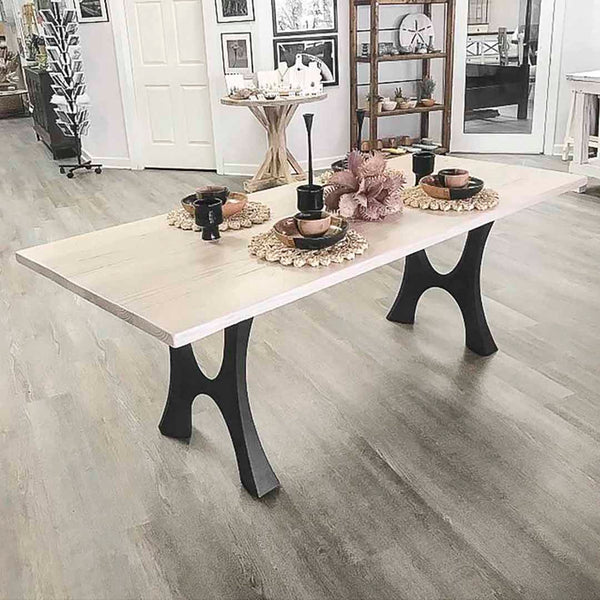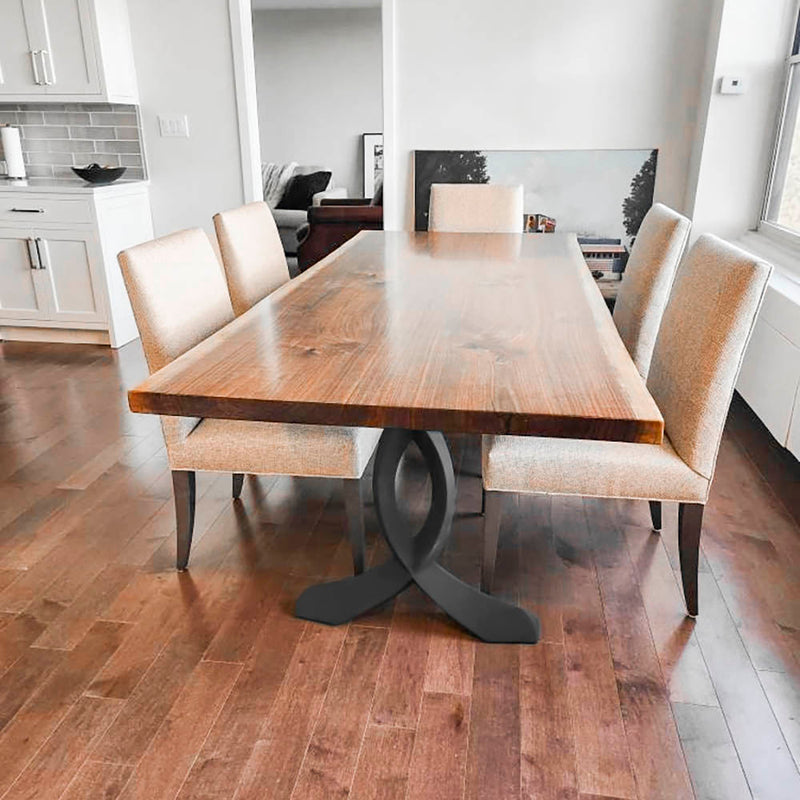Why Dining Room Table Legs Are Crucial for Your Table’s Stability
Why Dining Room Table Legs Are Crucial for Your Table’s Stability
Blog Article
Specialist Tips for Installing Dining-room Table Legs for Maximum Security
When it involves mounting dining room table legs, attaining optimum stability is extremely important for both capability and visual appeals. The procedure starts with picking the appropriate products and hardware, followed by careful placement and factor to consider of weight circulation. Each step plays a critical function in guaranteeing that the ended up product withstands everyday use without compromising security or style honesty. Nonetheless, comprehending the subtleties of these elements can dramatically affect the overall end result. What certain strategies can improve security even better?
Select the Right Legs
When picking the suitable legs for your eating room table, it is important to consider both functionality and looks. The legs you choose will considerably influence the overall style and security of the table. First, review the table's intended use; if you expect regular gatherings, stronger legs, such as those made from strong wood or steel, might be more appropriate, as they offer boosted resilience and support.
Common eating tables generally range from 28 to 30 inches in elevation, so make sure the legs line up with this criterion for convenience. Conical legs can add a contemporary touch, while transformed legs may communicate an extra classic aesthetic.

Select Appropriate Hardware
Just how can the right equipment boost the stability and longevity of your dining room table? The selection of suitable equipment is crucial to ensuring that the legs of your table are safely connected and able to hold up against regular usage. Premium screws, screws, and brackets offer the essential strength to sustain the weight of the table, as well as any type of added lots positioned upon it during gatherings or dishes.
When selecting screws, decide for those made from durable materials such as stainless-steel or brass, which resist corrosion and preserve integrity with time. The length of the screws is equally essential; they should penetrate deeply into the table's framework without endangering stability. For bolted links, consider making use of lock washing machines to avoid loosening up because of resonance or movement.
Furthermore, utilizing corner brackets can include additional support, specifically for bigger tables or those with much heavier tops. These brackets disperse weight uniformly and assist maintain the table's form. Making sure that the equipment you choose is suitable for the specific products of your table will certainly even more enhance its total security and long life, permitting you to appreciate your dining experience for many years to come.
Ensure Correct Positioning
Correct alignment of dining area table legs is vital for both aesthetic appeal and useful security. Misaligned legs can bring about an unequal tabletop, which might not only be visually uninviting however also compromise the table's use. To attain ideal alignment, start by determining the distance from the table's edges to the leg add-on points. This makes sure that each leg is positioned equidistant from the sides, producing a balanced appearance.
Use a degree during installation to validate that each leg is perpendicular to the tabletop. This step is essential, as also small inconsistencies can rise into considerable security issues over time. It is advisable to note the desired leg positions on the bottom of Full Article the table with a pencil or concealing tape prior to safeguarding them. This practice acts as an aesthetic overview, permitting for adjustments as needed.
Furthermore, verify the positioning after the first screws are tightened up, as modifications may be needed prior to totally safeguarding the hardware. By focusing on correct alignment, you not only improve the table's overall layout but additionally guarantee that it remains stable and functional for many years to find.

Take Into Consideration Weight Circulation
After making certain proper placement of the eating space Web Site table legs, it is necessary to take into consideration weight distribution to enhance security and performance. dining room table legs. Proper weight distribution is critical in protecting against ensuring and tottering that the table can support its intended tons without risk of tipping or collapsing
When placing the legs, ensure they are placed at equal ranges from the center of the table to equally distribute the weight throughout the structure. Take into consideration the weight of the tabletop and any kind of items that will regularly relax on it, such as decorative items or tabletop appliances. Tables with much heavier surface areas ought to preferably have legs located closer to the corners, as this makes best use of the base of assistance and minimizes the danger of instability.
Furthermore, if the table is meant for usage in a high-traffic area, take into consideration using larger materials for the legs or adding maintaining aspects, such as cross-bracing or a reduced shelf - dining room table legs. These adjustments can help maintain balance and stop shifting throughout use. Eventually, a well-considered weight circulation strategy will significantly boost the table's total performance, ensuring it stays a eye-catching and functional centerpiece for your dining space
Test Stability Prior To Use
Testing the stability of the dining-room table prior to usage is a critical step that must not be neglected. Making sure that the table is stable and protected can prevent crashes and prolong the life expectancy of the furnishings. Begin by using mild stress to over at this website numerous points on the table surface. Lower on the center and afterwards along the sides, moving or observing any type of wobbling. If the table reveals instability, recognize the legs or joints that might call for change.
Next, examine that all screws and bolts are tightened up effectively. Loosened connections can bring about instability and potential damages in time. If necessary, use timber glue on joints to boost security, making sure to enable adequate drying time.

Final Thought
To conclude, the installation of eating room table legs needs mindful consideration of materials, hardware, placement, and weight circulation to attain optimum security. By selecting high-quality fasteners and strong legs, guaranteeing specific positioning, and dispersing weight evenly, the structural integrity of the table can be substantially boosted. Conducting a stability test before normal usage further makes sure that the table will certainly withstand daily pressures, consequently giving a secure and reputable eating experience.
When it comes to installing dining room table legs, attaining maximum stability is extremely important for both functionality and aesthetic appeals. The legs you select will dramatically influence the total layout and stability of the table (dining room table legs). Basic dining tables generally vary from 28 to 30 inches in height, so ensure the legs align with this standard for convenience.Appropriate alignment of eating space table legs is necessary for both aesthetic charm and useful stability.In conclusion, the installment of dining space table legs needs careful factor to consider of products, hardware, positioning, and weight distribution to achieve optimum stability
Report this page